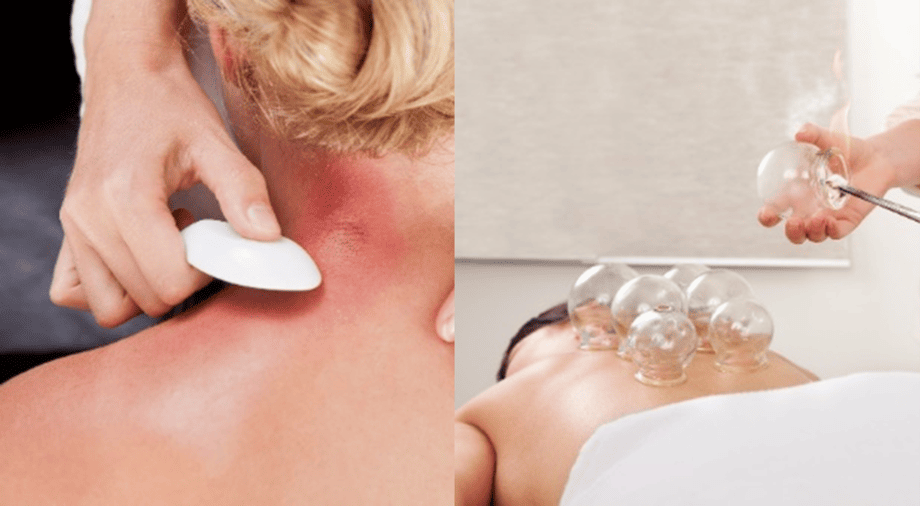Cupping Therapy Vs. Gua Sha: Traditional Techniques For Promoting Circulation And Healing

Cupping therapy and Gua Sha are traditional techniques that have been used for centuries in various cultures to promote circulation and healing. Both methods involve the use of tools to create suction or scraping motions on the skin, stimulating blood flow and relieving tension.
Cupping therapy utilizes cups that are placed on the skin to create a vacuum, while Gua Sha involves scraping the skin with a smooth-edged tool. These techniques have been employed to address a wide range of conditions and ailments, including pain, inflammation, and musculoskeletal disorders.
Cupping therapy and Gua Sha are believed to help improve circulation, release toxins, and promote the body’s natural healing processes. Incorporating cupping therapy and Gua Sha into a holistic health routine can provide a complementary approach to conventional medical treatments.
By understanding the history, mechanisms, and potential benefits of these traditional techniques, individuals can make informed decisions about incorporating them into their wellness practices.
History and Origins of Cupping Therapy and Gua Sha
The history and origins of cupping therapy and gua sha can be traced back to ancient Chinese medicine practices. Cupping therapy, also known as fire cupping, involves placing heated glass or bamboo cups onto the skin to create suction. This technique is believed to promote blood circulation and remove toxins from the body.
Gua sha, on the other hand, involves using a tool, such as a jade stone or a spoon, to scrape the skin. This scraping action is thought to stimulate blood flow and release stagnant energy.
Both cupping therapy and gua sha have been used for centuries in traditional Chinese medicine to treat various ailments and promote healing. These techniques have gained popularity in recent years as alternative therapies for pain relief and relaxation.
How Cupping Therapy Works
One method of treatment involves the application of suction cups to the skin, which is believed to enhance blood flow and promote the body’s natural healing processes. Cupping therapy works by creating a vacuum inside the cups, which are placed on specific areas of the body. This vacuum effect draws blood to the surface of the skin and increases circulation, delivering oxygen and nutrients to the tissues. It is thought to stimulate the lymphatic system, helping to remove toxins and waste products from the body. The table below provides a comparison between cupping therapy and gua sha, another traditional technique for promoting circulation and healing.
| Cupping Therapy | Gua Sha | ||
|---|---|---|---|
| Uses suction cups to create a vacuum effect | Scrapes the skin with a smooth-edged tool | ||
| Enhances blood flow and circulation | Stimulates blood flow and releases stagnant blood | ||
| Promotes the body’s natural healing processes | Helps to remove toxins and improve overall health | Improves muscle recovery and reduces muscle tension |
How Gua Sha Works
Gua sha is a traditional Chinese healing technique that involves scraping the skin with a smooth-edged tool to promote circulation and healing.
The tools used in gua sha can vary, but commonly include jade or horn instruments.
This technique is believed to have various benefits, including reducing pain and inflammation, improving blood circulation, and releasing tension in the muscles.
Tools and Techniques Used in Gua Sha
Incorporating various specialized tools, practitioners of gua sha employ specific techniques to promote the circulation of blood and qi energy, facilitating the body’s natural healing processes. Gua sha tools can be made of various materials such as jade, horn, or ceramic. The most commonly used tool is a smooth-edged instrument, often made of jade or other stones. The practitioner applies oil to the skin and then uses the tool to scrape the skin in long, firm strokes, typically in a specific direction and pattern. This scraping action creates redness or bruising known as “sha” marks, which are believed to release stagnation and promote the flow of blood and energy. Some practitioners also use other techniques, such as cupping or acupuncture, in combination with gua sha to enhance its effectiveness.
| Tools | Materials | Description |
|---|---|---|
| Smooth-edged instrument | Jade, horn, or ceramic | Used to scrape the skin and promote blood and energy flow |
| Gua sha oil | Various oils or balms | Applied to the skin before scraping to reduce friction |
| Cupping tools | Glass, bamboo, or plastic cups | Used in combination with gua sha to enhance treatment |
| These tools are commonly used in traditional Chinese medicine for therapeutic purposes. |
Benefits of Gua Sha
Enhancing the body’s natural healing processes, gua sha has been found to have numerous benefits for overall health and well-being. This traditional technique, originating from traditional Chinese medicine, involves scraping the skin with a smooth-edged tool to stimulate blood circulation and promote the release of toxins.
The benefits of gua sha include:
- Pain relief: Gua sha has been shown to alleviate musculoskeletal pain, such as neck and back pain, by increasing blood flow to the affected area.
- Reduced inflammation: The scraping motion of gua sha can help reduce inflammation in the body, making it beneficial for conditions like arthritis.
- Improved circulation: By promoting blood flow, gua sha can enhance overall circulation, which can have positive effects on various bodily functions.
- Detoxification: Gua sha stimulates the lymphatic system, aiding in the removal of waste and toxins from the body.
Overall, gua sha offers a natural, non-invasive approach to enhance healing and improve overall health.
Differences Between Cupping Therapy and Gua Sha
Cupping therapy and gua sha are distinct traditional techniques used for promoting circulation and healing, with cupping therapy involving the use of suction cups and gua sha utilizing a scraping tool.
While both methods aim to enhance blood flow and relieve muscle tension, there are notable differences between them. Cupping therapy creates negative pressure within the cups, which is believed to stimulate blood flow, loosen muscles, and release toxins. In contrast, gua sha involves applying pressure and scraping the skin with a smooth-edged tool to produce microtraumas, which are thought to increase blood circulation and promote healing.
Additionally, cupping therapy typically leaves circular marks on the skin due to the suction, while gua sha often results in redness and petechiae.
Overall, both cupping therapy and gua sha offer unique approaches to improving circulation and aiding in the healing process.
Similarities Between Cupping Therapy and Gua Sha
Both cupping therapy and gua sha share common goals in improving blood flow and providing therapeutic benefits. Both techniques involve the use of tools that create suction or scraping on the skin, which stimulates blood circulation and promotes healing.
Cupping therapy utilizes suction cups placed on the skin to create a vacuum effect, while gua sha involves scraping the skin with a tool made of jade or other materials. Both therapies are believed to release stagnation, improve Qi (energy) flow, and relieve muscle tension. Additionally, they are both used to treat various conditions such as pain, inflammation, and respiratory disorders.
Although cupping therapy and gua sha differ in their application methods, they both aim to enhance circulation and facilitate the body’s natural healing processes.
Conditions and Ailments Treated with Cupping Therapy
Various conditions and ailments can be effectively treated through the use of cupping therapy. This traditional technique involves creating a vacuum effect on the skin by placing cups on specific points of the body, which helps to improve circulation and promote healing. Cupping therapy has been used for centuries to address a wide range of health issues. It is commonly used to alleviate pain, such as back pain, neck pain, and muscle soreness. Additionally, cupping therapy can be beneficial for respiratory conditions, including asthma and bronchitis, as it helps to improve lung function and reduce inflammation. Furthermore, it is believed to enhance digestion and relieve digestive disorders such as irritable bowel syndrome (IBS) and constipation. Overall, cupping therapy offers a holistic approach to treating various conditions and promoting overall well-being.
| Conditions and Ailments Treated with Cupping Therapy | |||
|---|---|---|---|
| Back pain | |||
| Neck pain | |||
| Muscle soreness | |||
| Asthma | |||
| Bronchitis | Bronchitis | Chronic pain | |
| Arthritis | Fibromyalgia | ||
| Digestive issues | Migraines | ||
| Anxiety | Depression | ||
| Insomnia | Fatigue | ||
| High blood pressure | Allergies | ||
| Common cold | Sinusitis | ||
| Cellulite reduction | Sports injuries | ||
| Detoxification | Respiratory disorders | ||
| Skin conditions | Menstrual cramps | ||
| Overall wellness and relaxation |
Conditions and Ailments Treated with Gua Sha
Gua Sha is a technique that has been used for centuries to address a variety of conditions and ailments. It involves scraping the skin with a smooth-edged tool, such as a spoon or coin, to create petechiae or ‘sha’ marks. These marks are believed to indicate the release of stagnant blood and toxins from the body, promoting circulation and healing.
Gua Sha is commonly used to treat the following conditions:
- Musculoskeletal pain: Gua Sha is often used to alleviate pain and stiffness in muscles and joints. It is believed to help relax muscles, reduce inflammation, and improve range of motion.
- Respiratory conditions: Gua Sha is thought to help relieve congestion and promote better breathing in conditions such as asthma, bronchitis, and the common cold.
- Skin disorders: Gua Sha is used to address various skin conditions, including acne, eczema, and psoriasis. It is believed to promote blood flow to the skin and enhance the body’s natural healing processes.
Overall, Gua Sha is a traditional technique that is believed to promote circulation and healing in various conditions and ailments.
Incorporating Cupping Therapy and Gua Sha into a Holistic Health Routine
Incorporating cupping therapy and gua sha into a holistic health routine can enhance overall well-being and provide additional benefits beyond traditional methods of treatment. These ancient techniques promote circulation, relieve muscle tension, and stimulate the body’s natural healing response. Cupping therapy involves placing cups on the skin to create suction, which helps to release toxins and improve blood flow. Gua sha, on the other hand, involves scraping the skin with a smooth-edged tool to stimulate blood circulation and reduce inflammation. By incorporating these practices into a holistic health routine, individuals can experience improved energy flow, reduced pain, and enhanced relaxation. Moreover, these techniques have been found to promote stress reduction, improve sleep quality, and support emotional well-being.
| Benefits of Incorporating Cupping Therapy and Gua Sha | |
|---|---|
| Improved circulation | Enhanced relaxation |
| Reduced muscle tension | Stress reduction |
| Increased energy flow | Improved sleep quality |
| Toxin release | Emotional well-being |
| Pain reduction |
Frequently Asked Questions
Are cupping therapy and gua sha techniques painful?
Both cupping therapy and gua sha techniques can cause discomfort, but the level of pain experienced varies among individuals. The sensation can range from mild to moderate, and some may find it soothing or therapeutic, while others may find it more intense.
Can cupping therapy or gua sha be used to treat mental health conditions?
Cupping therapy and gua sha have traditionally been used to promote physical healing and circulation in the body. However, there is limited scientific evidence to support their efficacy in treating mental health conditions. Further research is needed in this area.
Are there any potential side effects or risks associated with cupping therapy or gua sha?
Potential side effects of cupping therapy include temporary bruising, skin irritation, and discomfort. Gua sha may cause minor bruising, pain, or skin abrasions. However, serious complications are rare when performed by trained practitioners and following proper hygiene practices.
How long does it typically take to see results from cupping therapy or gua sha treatments?
Results from cupping therapy or gua sha treatments can vary depending on the individual and the specific condition being treated. Some individuals may experience immediate relief, while others may require multiple sessions over a period of weeks or months to see noticeable improvements.
Can cupping therapy or gua sha be done at home, or is it necessary to see a professional practitioner?
Both cupping therapy and gua sha can be safely performed at home with proper knowledge and guidance. However, consulting a professional practitioner is recommended to ensure correct technique and avoid any potential risks or complications.








